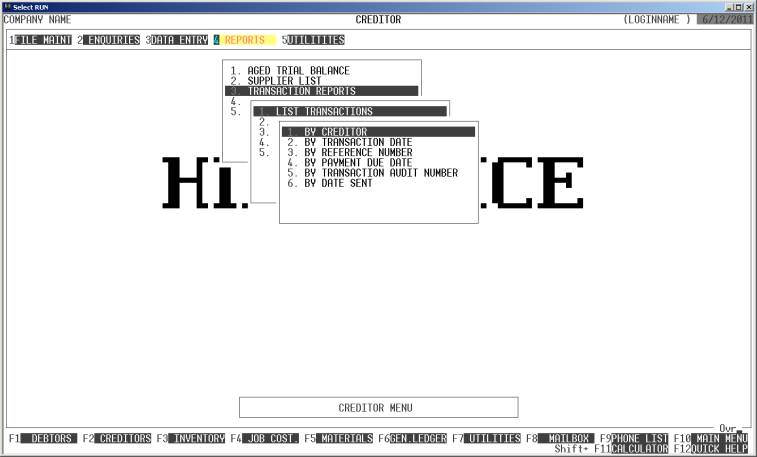HiFinance
5
SECTION
2.4.3.1 - LIST CREDITOR TRANSACTIONS
USAGE: To print a list of Creditor Transactions.
DISCUSSION: When you choose this option, the screen will
appear as follows:

Here you can choose the order in which you wish to
print the report.
If you have enabled the DATE SENT option, an
extra menu option will be included. This will lead you to a special program
that is optimised for searching and listing transactions for the date they were
sent. In this case, the list of options for printing will be a subset of those
listed below.
Hint: If you intend to limit the report to a range of
transactions, it is most efficient to print the report in the same order. Eg if
you wish to limit the report to a range of dates, the report will scan the
transaction-file faster if you also print the report in date order.
Having chosen from the options, the following
questions will appear:
USE LONG FORMAT REPORT If you are using wide stationery, reply Y, otherwise reply N. This question will only be
displayed if the relevant option is set to A, see SECTION 7.1.2.
START A NEW PAGE ON
CHANGE OF KEY If you have chosen to print
the report in Creditor or Date order, you will be offered this option. If you
reply Y, HiFinance will start a new
page each time the major key changes. A sub-total will also be printed for each
group of transactions. If you reply N, the transactions will be
printed continuously.
UNALLOCATED TRANSACTIONS
ONLY This option is particularly useful
for picking up unpaid Purchases. If you answer Y,
HiFinance will mask any full paid transactions.
The following question asks you to enter both a
lower and upper limit. The upper limit must not be less than the lower limit.
The default answers define the extreme limits of the field. You do not have to
change all of these limits. Only change the ones you wish to, and tab past the
others.
CREDITOR CODE RANGE This is the Creditor’s code.
CREDITOR GROUP RANGE This is the Creditor’s group as it stood at the time the
transaction was created.
TRANSACTION DATE RANGE This is the transaction date.
TRANSACTION VALUE RANGE This is the total value of the transaction.
REFERENCE RANGE This reference number, eg Purchase number.
OTHER KEY RANGE This may appear as a different literal depending on how
you have defined the field in SYSTEM
PARAMETERS.
AUDIT NUMBER RANGE This Transaction Audit Number. Printing in this order will sort
the report in the order the transactions were entered into the system
irrespective of whether a transaction was forward or backdated.
DUE DATE RANGE This is the date you are due to pay for the goods. This range is
only relevant for Purchases.
In all cases, the default answers are the extreme
limits of each range, so if you do not wish to limit the report on a particular
field, just bypass it.
INCLUDE ALL TRANSACTION
TYPES If you wish to print exclude any
transaction types, enter N here and you will be
presented with a complete list of Creditor transaction types to choose from. If
you wish to include all transaction types, simply enter Y.
To start the report, press <Enter> through each field or simply press <F10>.
The report will scan the transaction file and extract
all records that fit within your chosen parameters. The report itself will
detail the Creditor code, Creditor Group, Audit Number, Transaction Date,
Transaction Type, Debit or Credit Value, reference number and the transaction
details. If you have chosen to print only unallocated transactions, the Debit
and Credit columns are replaced with Transaction Value and Unallocated Value.
At the end of the report, the monetary columns are totalled.